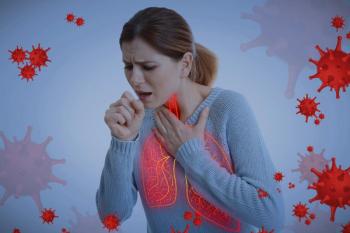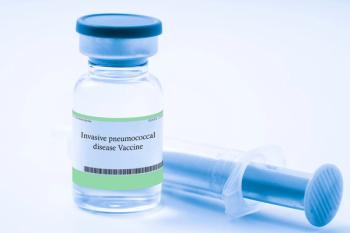
Evolving Perspectives on Pneumococcal Vaccination Across Adult Populations
Evolving Perspectives on Pneumococcal Vaccination Across Adult Populations
Community-acquired pneumonia is one of the leading infectious causes of hospital admission; further, it is associated with high rates of morbidity and mortality.1,2 Streptococcus pneumoniae remains the most common bacterial cause of pneumonia, accounting for approximately 227,000 hospitalizations annually and an estimated 25% mortality rate within 1 year of hospitalization.3,4 Additional complications of pneumococcal disease can range from noninvasive syndromes (acute otitis media, sinusitis) to invasive pneumococcal disease (IPD), including meningitis and bacteremia.5
Prevention of pneumococcal disease through routine vaccination has led to substantial declines in IPD, particularly in serotypes covered in the pneumococcal conjugate vaccines (PCV).5,6 Since 2010, the Centers for Disease Control and Prevention (CDC) Advisory Committee on Immunization Practices (ACIP) has recommended the routine use of the 13-valent pneumococcal vaccine (PCV-13) for all children aged 14 to 59 months.7 This recommendation has led to direct declines in PCV-13 serotype pneumococcal disease in children and an indirect decline in adults, highlighting the importance of vaccination efforts to protect at-risk patients.3,8,9 Adults at highest risk of IPD include those older than 50 years, those aged 19 to 49 years who smoke or have certain comorbidities (eg, heart disease, diabetes, chronic obstructive pulmonary disease), and immunocompromised individuals.10,11 Additionally, racial disparities in pneumococcal disease continue to disproportionately affect certain groups, with IPD rates higher in non-Hispanic Black and non-Hispanic American Indian or Alaska Native adults compared to the general population.12
To mitigate IPD caused by non–PCV-13 serotypes, several new pneumococcal vaccines have been approved for the prevention of IPD, including a 15-valent (PCV-15), 20-valent (PCV-20), and 21-valent (PCV-21) pneumococcal vaccine.12 Based on the CDC’s Active Bacterial Core Surveillance, approximately 54% to 62% and 77% to 85% of IPD cases between 2018-2022 were due to pneumococcal vaccine serotypes contained in PCV-20 and PCV-21, respectively.13 Unfortunately, overall risk-based pneumococcal vaccination coverage among adults remains low, with only 22% of adults aged 19 to 64 years who have risk factors receiving at least 1 dose of pneumococcal vaccine.14 Rates of vaccination additionally differ by race and health care accessibility, with vaccination rates generally lower among Black or Hispanic adults and those without a usual place to receive health care.14
Expanding Protection: ACIP’s Latest Adult Pneumococcal Vaccine Recommendation
As of October 23, 2024, the ACIP expanded the recommended use of a PCV from the previous recommendation of adults 65 years or older to include all PCV-naïve adults 50 years and older.12 The recommendation for PCV in adults aged 19 to 49 years with risk factors remains unchanged.12,15 Available vaccine options include PCV-15 (Vaxneuvance; Merck), PCV-20 (Prevnar 20; Pfizer), and PCV-21 (Capvaxive; Merck).12 The 3 PCVs offer protection against different pneumococcal serotypes.16 If PCV-15 is selected, administration of pneumococcal polysaccharide vaccine (PPSV-23) is recommended at least 1 year later (or at least 8 weeks later if the patient is immunocompromised) to confer protection against 8 additional serotypes not covered in PCV-15.15,17 If PCV-20 or PCV-21 is used, a follow-up PPSV-23 dose is not needed, as these 2 vaccines confer broader protection of prevalent serotypes compared to PCV-15.16,17 Of note, PCV-20 confers protection against the same 15 serotypes as PCV-15 plus 5 additional serotypes.15 Although PCV-21 offers more broad protection against 11 serotypes not prevalent in PCV-15 or PCV-20, it does not include serotype 4; this is an important consideration in regions such as the western United States, where this serotype remains highly prevalent among adults younger than 65 years who smoke, are homeless, use injectable drugs, or have underlying conditions (eg, alcoholism, chronic lung disease).12,15,16 Vaccine selection should take into account local serotype distribution and individual patient risk factors. Individuals who previously started the pneumococcal vaccine series with PCV-13 or PPSV-23 should receive an updated PCV vaccine; timing and product selection will vary depending on the initial vaccine received.12
The expansion of the recommendation for PCV administration to adults at least 50 years of age aims to reduce disease burden in patients aged 50 to 64 years, increase access to preventative care in patients at high risk for IPD, and reduce racial disparities seen in IPD.13 The shift in recommendation for the administration of expanded serotype vaccines (eg, PCV-20, PCV-21, or PCV-15 plus PPSV-23 instead of PCV-13) is designed to combat the substantial burden of non–PCV-13 serotypes that account for 42% and 75% of IPD in children and adults, respectively.18 The expanded age recommendation attempts to ensure that patients at moderate to high risk for IPD are readily identified and able to access vaccines.19 Previous data suggested that over 80% of patients aged 50 to 64 years who were hospitalized with pneumococcal pneumonia had at least 1 risk factor (eg, heart disease, lung disease, liver disease, diabetes) that put them at higher risk of IPD.2 According to 2022 Behavioral Risk Factor Surveillance System Data, among the general population, an estimated 32% to 54% of adults aged 50 to 64 years qualify for a risk-based pneumococcal vaccine, although only an estimated 37% of eligible adults aged 50 to 64 years were vaccinated.12 Rates of vaccination were higher in patients older than 65 years who were identified based on an age cutoff instead of a risk-based system, suggesting that a streamlined age-based approach may be easier to follow.12
In addition to capturing patients at high risk based on comorbidities, previous data suggested that peak rates of IPD occur at a younger age (55-59 years) in Black males, highlighting a population that previously would not have been identified as candidates for pneumococcal vaccination using comorbidity-based risk assessment.12,13 By simplifying the PCV recommendation to include adults older than 50 years, patients who would benefit most from pneumococcal vaccination may be more readily identified, which may help reduce pneumococcal-associated morbidity and mortality and improve public health.
Clinical Considerations for Pharmacists
Pharmacists can play a key role in preventing pneumococcal infection by administering pneumococcal vaccines in the community and health care settings. Identifying patients eligible for pneumococcal vaccination should involve stepwise decision-making. Key factors to consider include age, underlying medical conditions, and vaccine history.20
For adults at least 50 years of age or aged 19 to 49 years with risk factors (alcoholism, chronic heart disease, chronic liver disease, chronic lung disease, cigarette smoking, or diabetes) who have not previously received a pneumococcal vaccine, PCV-15, PCV-20, or PCV-21 should be administered (
For patients who previously started the pneumococcal vaccine series, the timing and selection of vaccine will differ depending on the prior vaccine schedule.17 For adults who previously were given PPSV-23 only, a single dose of PCV-15, PCV-20, or PCV-21 should be administered at least 1 year after the last PPSV-23 dose.17 For adults who previously were given PCV-13 only, a single dose of PCV-20 or PCV-21 is recommended at least 1 year after PCV-13, and PPSV-23 is no longer needed.17 For adults who were given PCV-13 and PPSV-23 (1 or 2 doses), a single dose of PCV-20 or PCV-21 may be recommended 5 years or longer after the last pneumococcal vaccine depending on age, risk factors, and shared clinical decision-making.12
Implementation and the Role of the Pharmacist
Pharmacists are vital for improving pneumococcal vaccine access to eligible patients. Patients visit their community pharmacists approximately twice as much as they visit other health care professionals, highlighting the key role the pharmacist can play in reaching a wide patient demographic.21 Additionally, as the role of the pharmacist evolves to encompass more holistic care through medication therapy management (MTM) and chronic disease consults, opportunities to screen for patient eligibility are expected to increase further. Using the CDC’s PneumoRecs VaxAdvisor tool, pharmacists can enter a patient’s age, vaccine history, and underlying medical history during MTM visits to get streamlined recommendations.20 With the updated 2024 ACIP guidance, pharmacists should look for previously missed opportunities for vaccination, especially in adults aged 50 to 64 years.12
During the COVID-19 pandemic, pharmacists administered an overwhelming 90% of COVID-19 vaccines. Rates of pneumococcal vaccines administered by a pharmacist are comparatively low, with only 40% to 50% of pneumococcal vaccines given in a pharmacy setting.22 In a study evaluating barriers to pneumococcal vaccination in community pharmacy, Davies et al highlighted the complexity of the previous ACIP guideline recommendations as a barrier with limited knowledge of guideline application.23 Streamlining of recent guidelines may help to alleviate this barrier. Additional methods of increasing pneumococcal vaccine uptake in pharmacies may involve use of automated alerts in electronic medical records (EMRs) or automated reminders via patient health records, text messages, or emails.24 Using a best practice alert in the EMR for patients who met pneumococcal vaccine eligibility, Kapoor et al was able to demonstrate a statistically significant increase in patients receiving at least 1 pneumococcal vaccine dose.25 Similarly, the use of automated vaccine reminder calls has been previously described in the literature, although results are mixed depending on the vaccine type and patient population.26
Outside of vaccine administration, the other key role of the pharmacist in implementing updated ACIP guidance is vaccine education. With an ever-changing vaccine landscape in the world of COVID-19, patients should be armed with a good understanding of the difference between annual influenza and COVID-19 vaccines compared to vaccines that are only administered once (eg, respiratory syncytial virus, pneumococcal).17 Additionally, in a health care climate where vaccine hesitancy is increasingly prevalent, the pharmacist must be adequately prepared to combat medical misinformation and ensure the patient has a good understanding of the risks and benefits of vaccines.27,28 Patients may be unaware of the new ACIP guidance or may not be familiar with data supporting the expanded age recommendation. By educating patients on the goals of expanding access to high-risk individuals and addressing racial and ethnic disparities in pneumococcal rates, patients may have a better understanding of the importance of obtaining their pneumococcal vaccine.
Looking Ahead
The expanded ACIP guidance recommending pneumococcal vaccine for adults 50 years or older is a key step in closing persistent adult immunization gaps. Through an updated, streamlined, age-based approach, high-risk populations will be more easily identified, which will hopefully increase the rates of vaccine equity and reduce pneumococcal-associated complications across multiple demographics. Pharmacists are well-positioned to enact the ACIP recommendations through patient education and routine screening. Future areas of need include ongoing education on long-term pneumococcal vaccine protection, cross-sector collaboration with other health care professionals, and tools for automated patient identification.
REFERENCES
1. National Center for Biotechnology Information. July 13, 2021. Accessed July 21, 2025. https://www.ncbi.nlm.nih.gov/books/NBK573113/f
2. Self WH, Johnson KD, Resser JJ, et al. Prevalence, clinical severity, and serotype distribution of pneumococcal pneumonia among adults hospitalized with community-acquired pneumonia in Tennessee and Georgia, 2018-2022. Clin Infect Dis. 2024;79(4):838-847. doi:10.1093/cid/ciae316
3. Pneumococcal disease surveillance and trends. CDC. Updated September 9, 2024. Accessed May 19, 2025. https://www.cdc.gov/pneumococcal/php/surveillance/index.html
4. Ramirez J, Furmanek S, Chandler TR, et al. Epidemiology of pneumococcal pneumonia in Louisville, Kentucky, and its estimated burden of disease in the United States. Microorganisms. 2023;11(11):2813. doi:10.3390/microorganisms11112813
5. Chapman R, Sutton TC, MacDonald NE, et al. The role of pneumococcal conjugate vaccines in reducing antimicrobial resistance. Vaccine. 2020;38(31):4865-4871. doi:10.1016/j.vaccine.2020.05.054
6. Antibiotic-resistant Streptococcus pneumoniae. CDC. December 17, 2024. Accessed May 19, 2025. https://www.cdc.gov/pneumococcal/php/drug-resistance/index.html
7. CDC. Invasive pneumococcal disease and 13-valent pneumococcal conjugate vaccine (PCV13) coverage among children aged ≤59 months—selected U.S. regions, 2010-2011. MMWR Morb Mortal Wkly Rep. 2011;60(43):1477-1481. https://www.cdc.gov/mmwr/preview/mmwrhtml/mm6043a3.htm
8. Moore MR, Link-Gelles R, Schaffner W, et al. Effect of use of 13-valent pneumococcal conjugate vaccine in children on invasive pneumococcal disease in children and adults in the USA: analysis of multisite, population-based surveillance. Lancet Infect Dis. 2015;15(3):301-309. doi:10.1016/S1473-3099(14)71081-3
9. Balsells E, Guillot L, Nair H, Kyaw MH. Serotype distribution of Streptococcus pneumoniae causing invasive disease in children in the post-PCV era: a systematic review and meta-analysis. PLoS One. 2017;12(5):e0177113. doi:10.1371/journal.pone.0177113
10. Kobayashi M, Pilishvili T, Farrar JL, et al. Pneumococcal vaccine for adults aged >19 years: recommendations of the Advisory Committee on Immunization Practices, United States, 2023. MMWR Recomm Rep. 2023;72(3):1-42.
11. Grant LR, Meche A, McGrath L, et al. Risk of pneumococcal disease in US adults by age and risk profile. Open Forum Infect Dis. 2023;10(5):ofad192. doi:10.1093/ofid/ofad192
12. Kobayashi M, Leidner AJ, Gierke R, et al. Expanded recommendations for use of pneumococcal conjugate vaccines among adults aged ≥50 years: recommendations of the Advisory Committee on Immunization Practices—United States, 2024. MMWR Morb Mortal Wkly Rep. 2025;74(1):1-8.
doi:10.15585/mmwr.mm7401a1
13. Kobayashi M. Summary of work group interpretations of EtR and policy option on PCV21 Use in adults. Presented at: the Advisory Committee on Immunization Practices (ACIP) Meeting; June 27, 2024; Atlanta, GA. CDC. Accessed May 19, 2025. https://www.cdc.gov/acip/downloads/slides-2024-06-26-28/04-Pneumococcal-Kobayashi-508.pdf
14. Hung MC, Srivastav A, Lu PJ, et al. Vaccination coverage among adults in the United States, National Health Interview Survey, 2021. CDC. July 19, 2024. Accessed May 19, 2025.
https://www.cdc.gov/adultvaxview/publications-resources/vaccination-coverage-adults-2021.html
15. Kobayashi M, Leidner A, Geirke R, et al. Use of 21-valent pneumococcal conjugate vaccine among U.S. adults: recommendations of the Advisory Committee on Immunization Practices — United States, 2024. MMWR Morb Mortal Wkly Rep. 2024;73(36):793-798. doi:10.15585/mmwr.mm7336a3
16. De Wals P. A new approach to define the optimal immunization strategy against pneumococcal disease: the example of Canada. Epidemiol Infect. 2025;153:e55. doi:10.1017/S0950268825000305
17. Recommended adult immunization schedule for ages 19 years or older, United States, 2025. CDC. November 21, 2024. Accessed May 19, 2025. https://www.cdc.gov/vaccines/schedules/hcp/imz/adult.html
18. Isturiz R, Grant L, Gray S, et al. Expanded analysis of 20 pneumococcal serotypes associated with radiographically confirmed community-acquired pneumonia in hospitalized US adults. Clin Infect Dis. 2021;73(7):1216-1222. doi:10.1093/cid/ciab375
19. EtR framework for adults aged 50-64 years who have not received a pneumococcal conjugate vaccine. CDC. Advisory Committee on Immunization Practices. January 6, 2025. Accessed June 17, 2025.
https://www.cdc.gov/acip/evidence-to-recommendations/adults-50-64-without-pneumococcal-vaccine-etr.html
20. Valliant SN, Burbage SC, Pathak S, Urick BY. Pharmacists as accessible health care providers: quantifying the opportunity. J Manag Care Spec Pharm. 2022;28(1):85-90. doi:10.18553/jmcp.2022.28.1.85
21. PneumoRecs VaxAdvisor: pneumococcal vaccine recommendations. CDC. December 11, 2024. Accessed May 19, 2025. https://www2a.cdc.gov/vaccines/m/pneumo/pneumo.html
22. Trends in vaccine administration in the United States. 2023. IQVIA Institute for Human Data Science. https://www.iqvia.com/insights/the-iqvia-institute/reports-and-publications/reports/trends-in-vaccine-administration-in-the-united-states
23. Davies A, Schreiber D, Carey C, et al. Community pharmacists’ pneumococcal vaccine knowledge and perceived barriers to vaccination. Vaccine. 2025;53:126930. doi:10.1016/j.vaccine.2025.126930
24. Shapiro Ben David S, Shamai-Lubovitz, Mourad V, et al. A nationwide digital multidisciplinary intervention aimed at promoting pneumococcal vaccination in immunocompromised patients. Vaccines (Basel). 2023;11:1355. doi:10.3390/vaccines11081355
25. Kapoor S, Sheth HS, DeSilva R, Aggarwal R. Best practice alerts in electronic medical records to improve pneumococcal vaccination in CKD. Am J Kidney Dis. 2024;81(2):245-246. doi:10.1053/j.ajkd.2022.06.010
26. Hurley LP. Immunization practices in 2018: challenges and opportunities. Am J Manag Care. 2018;24(13; suppl):SP491-SP497. Accessed May 19, 2025.
https://www.ajmc.com/view/immunization-practices-in-2018-challenges-and-opportunities
27. Gilliland K, Kilinsky A. Vaccine hesitancy: where are we now? Pediatr Ann. 2025;54(5):e154-e159. doi:10.3928/19382359-20250307-01
28. Kempe A, Saville A, Albertin C, et al. Parental hesitancy about routine childhood and influenza vaccinations: a national survey. Pediatrics. 2020;146(1):e20193852 doi:10.1542/peds.2019-3852
Newsletter
Pharmacy practice is always changing. Stay ahead of the curve with the Drug Topics newsletter and get the latest drug information, industry trends, and patient care tips.




































































































































